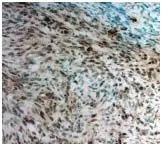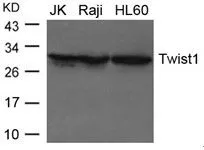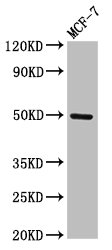
IHC-P analysis of mouse pancreatic cancer tissue sections using GTX50821 Twist1 antibody.
Twist1 antibody
GTX50821
ApplicationsWestern Blot, ImmunoHistoChemistry, ImmunoHistoChemistry Paraffin
Product group Antibodies
TargetTWIST1
Overview
- SupplierGeneTex
- Product NameTwist1 antibody
- Delivery Days Customer9
- Application Supplier NoteWB: 1: 500-1:1000. IHC-P: 1:100-1:500. *Optimal dilutions/concentrations should be determined by the researcher.Not tested in other applications.
- ApplicationsWestern Blot, ImmunoHistoChemistry, ImmunoHistoChemistry Paraffin
- CertificationResearch Use Only
- ClonalityPolyclonal
- Concentration1 mg/ml
- ConjugateUnconjugated
- Gene ID7291
- Target nameTWIST1
- Target descriptiontwist family bHLH transcription factor 1
- Target synonymsACS3, BPES2, BPES3, CRS, CRS1, CSO, SCS, SWCOS, TWIST, bHLHa38, twist-related protein 1, B-HLH DNA binding protein, H-twist, TWIST homolog of drosophila, class A basic helix-loop-helix protein 38, twist basic helix-loop-helix transcription factor 1, twist homolog 1
- HostRabbit
- IsotypeIgG
- Protein IDQ15672
- Protein NameTwist-related protein 1
- Scientific DescriptionThis gene encodes a basic helix-loop-helix (bHLH) transcription factor that plays an important role in embryonic development. The encoded protein forms both homodimers and heterodimers that bind to DNA E box sequences and regulate the transcription of genes involved in cranial suture closure during skull development. This protein may also regulate neural tube closure, limb development and brown fat metabolism. This gene is hypermethylated and overexpressed in multiple human cancers, and the encoded protein promotes tumor cell invasion and metastasis. Mutations in this gene cause Saethre-Chotzen syndrome in human patients, which is characterized by craniosynostosis, ptosis and hypertelorism. [provided by RefSeq, Aug 2017]
- Storage Instruction-20°C or -80°C,2°C to 8°C
- UNSPSC12352203
References
- IL-1beta induced methylation of the estrogen receptor ERalpha gene correlates with EMT and chemoresistance in breast cancer cells. Jimenez-Garduno AM et al., 2017 Aug 26, Biochem Biophys Res CommunRead more
- Over-expression of cofilin-1 suppressed growth and invasion of cancer cells is associated with up-regulation of let-7 microRNA. Tsai CH et al., 2015 May, Biochim Biophys ActaRead more



![ELISA analysis of antigen using GTX60657 Twist1 antibody [2F8E7]. Black : Control antigen 100ng Purple : Antigen 10ng Blue : Antigen 50ng Red : Antigen 100ng](https://www.genetex.com/upload/website/prouct_img/normal/GTX60657/GTX60657_20170912_ELISA_w_23061123_112.webp)
![ELISA analysis of antigen using GTX60776 Twist1 antibody [10E4E6]. Black : Control antigen 100ng Purple : Antigen 10ng Blue : Antigen 50ng Red : Antigen 100ng](https://www.genetex.com/upload/website/prouct_img/normal/GTX60776/GTX60776_20170912_ELISA_w_23061123_861.webp)
